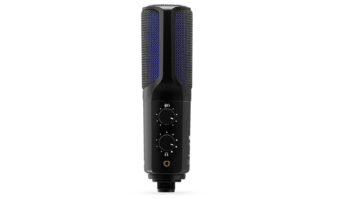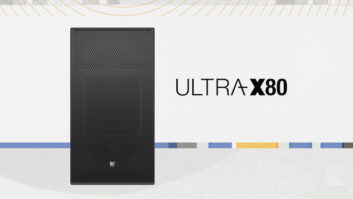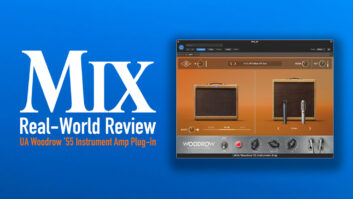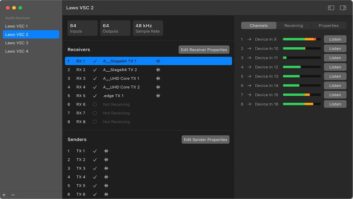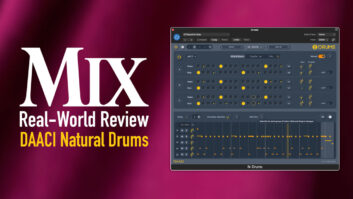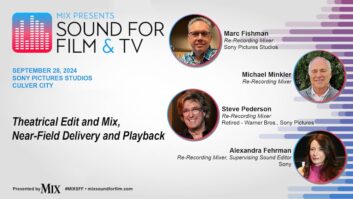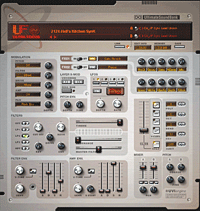

Purists believe that virtual instruments that emulate classic synthesizers never sound quite as good as the real thing. The engineers at Ultimate Sound Bank (USB) agree. In their quest to produce a plug-in anthology of the most popular synthesizers ever made, USB decided to sample custom patches played on classic hardware synths. They then fitted the plug-in with a GUI using familiar subtractive-synthesis controls. The result is Ultra Focus ($399), an editable ROMpler (sample player) that is one of the most impressive-sounding, versatile and user-friendly virtual instruments on the market.
HIGH-END SOUND QUALITY
USB used varied high-end recording gear to do the sampling for Ultra Focus, and the character of those audio paths is clearly audible. Simply put, Ultra Focus sounds awesome. More than 50 synthesizers were sampled (see a partial list at www.mixonline.com) to create more than 8 GB of content. Most of Ultra Focus’ presets incorporate the sound of one synth (although some stacks are included) to easily organize and preserve the identity of historic synth sounds.
Ultra Focus’ GUI offers familiar synth controls.
However, the plug-in’s dual-layer architecture allows you to combine two multi-sampled presets to create hybrid sounds. These can be a constant stack or you can use a mod wheel or other controller to morph between the two layers. You can also use one layer to modulate, or vocode, the other. Incredibly, Ultra Focus also includes almost 200 presets comprising basic waveforms (with every note sampled) from nearly every major classic synth, so you can roll your own patches from scratch.
Presets are organized and accessed within the plug-in via a pop-up menu representing each synthesis type. Each type is further divided into submenus that thoughtfully group presets together according to their application (synth bass, pads, strings, sweeps and so on). This arrangement makes it easy to find the right sound from the more than 2,000 quality presets within Ultra Focus.
TWEAKER’S DELIGHT
You can edit Ultra Focus’ two layers independently or simultaneously. Each layer can have its level, pan, mute status and pitch (both coarse and fine) adjusted independently of the other layer. You can also choose one of four defeatable filters (three lowpass filters and one highpass filter) to apply to each layer; a set of common filter controls — frequency cut-off, resonance, drive (distortion), keyboard tracking and envelope amount — retains the current settings for the layer no matter which filter is chosen.
Pitch, filter, amplifier, drive and pan can each be modulated independently for each layer by any one of 20 modulation sources (including velocity, after-touch, mod wheel and two host-synchable low-frequency oscillators); a dedicated depth control for each destination adjusts the amount of modulation. Two ADSR envelopes control the filter and amplifier for each layer, and the envelopes’ attack and decay times can each be modulated by velocity.
Parameters that control both layers simultaneously include velocity curve, polyphony, octave, glide, solo, pitch-bend range, controls for a master filter (highpass or lowpass with adjustable cut-off and resonance), two more tempo-synchable LFOs and two defeatable effects (also tempo-synchable). Twenty-nine quality effect algorithms — mostly time-based effects, filters, distortion and dynamics processors — are included and offer up to five adjustable parameters each. I wish Ultra Focus could accept audio input so it could be used as a processor.
ROOM TO GROW
Although the sound quality is impeccable, Ultra Focus does have some faults. Edited presets show no indication that an edit was made and tweaks should be saved. You cannot gang the layers’ two output fader controls to make global output level adjustments while retaining the relative balance between the two layers. Switching Ultra Focus’ time-based effects presets often crashed Digital Performer V. 4.52, and two of the auto-wah presets silenced the plug-in’s output. The only way to refresh Ultra Focus’ directory listing of presets is closing and re-instantiating the plug-in. The effects parameters are not documented in the manual. MIDI program change is not supported.
Some limitations can be overcome with creative solutions. For instance, although Ultra Focus is not multitimbral, you can use multiple instantiations as a workaround. While you can’t automate Ultra Focus’ controls, you can use MIDI continuous controllers with a sequencer to accomplish much the same thing.
HOW WAS IT?
Ultra Focus gobbled up a fair amount of CPU power on my dual 867MHz G4 running Digital Performer V. 4.52. With no audio tracks playing, buffer set to 256 samples and polyphony set to 10 voices while playing two layered presets of sustained sounds without a sustain pedal, my peak CPU load was roughly 75 percent.
If you’re looking for a phat plug-in that covers virtually all traditional synth-based sounds in one nut, this is it. Ultra Focus has become one of my favorite virtual instruments, as it offers a tremendous variety of impressive synth sounds with an intuitive interface that encourages tweaking.
Supported formats include DXi, VST and RTAS for PCs, and VST, MAS, AudioUnits and RTAS for Macs.
Ultimate Sound Bank (dist. by ILIO), 800/747-4546, www.ilio.com.

History Repeats Itself
by Michael Cooper
Instruments used to create sounds in Ultra Focus include an impressive array of subtractive (analog), FM, wavetable, vector, additive, PCM, phase-distortion, and analog-modeling synths. Here’s a partial list:
Roland: Jupiter 4, Jupiter 8, SH-101, JD800 and JD-990
Yamaha: CS80, CS60, CS15, CS40-M, CS70-M, DX1, DX100, TX and FS1R
Oberheim: X-Pander, Matrix 6, 4 Voices and OBXa
Sequential Circuits: Prophet VS, Prophet 5, Prophet One and T8
PPG: Wave 2.0, Wave 2.3, Waveterm B, PRK FD, EVU, HDU and Commander
Korg: PS3200, Trident MK2, MS20, M1, 01W and DW8000
Casio: CZ1, CZ100, VZ1 and VZ10M.
Moog: Minimoog and Memorymoog
ARP: Odissey, ARP2600 and Chroma
Waldorf: Pulse, Wave, Microwave XT, Q and Micro Q
Miscellaneous: Synclavier II, Technos Acxel, Mellotron M400, Acces Virus and Kawai K5000.
